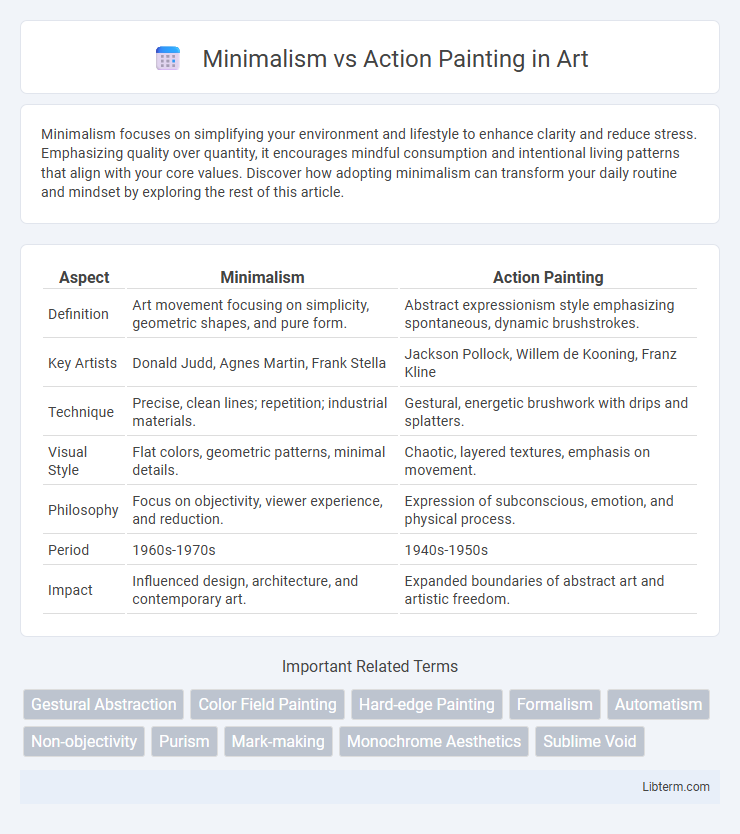Minimalism focuses on simplifying your environment and lifestyle to enhance clarity and reduce stress. Emphasizing quality over quantity, it encourages mindful consumption and intentional living patterns that align with your core values. Discover how adopting minimalism can transform your daily routine and mindset by exploring the rest of this article.
Table of Comparison
| Aspect | Minimalism | Action Painting |
|---|---|---|
| Definition | Art movement focusing on simplicity, geometric shapes, and pure form. | Abstract expressionism style emphasizing spontaneous, dynamic brushstrokes. |
| Key Artists | Donald Judd, Agnes Martin, Frank Stella | Jackson Pollock, Willem de Kooning, Franz Kline |
| Technique | Precise, clean lines; repetition; industrial materials. | Gestural, energetic brushwork with drips and splatters. |
| Visual Style | Flat colors, geometric patterns, minimal details. | Chaotic, layered textures, emphasis on movement. |
| Philosophy | Focus on objectivity, viewer experience, and reduction. | Expression of subconscious, emotion, and physical process. |
| Period | 1960s-1970s | 1940s-1950s |
| Impact | Influenced design, architecture, and contemporary art. | Expanded boundaries of abstract art and artistic freedom. |
Introduction to Minimalism and Action Painting
Minimalism emphasizes simplicity, focusing on geometric shapes and monochromatic palettes to create a sense of order and clarity. Action Painting, a subset of Abstract Expressionism, highlights dynamic, spontaneous brushstrokes and the physical act of painting as integral to the artwork's meaning. Both movements emerged in the mid-20th century, challenging traditional notions of composition and expression in the art world.
Historical Origins of Minimalism
Minimalism emerged in the late 1950s as a reaction against the emotional intensity and complexity of Action Painting, which dominated the New York art scene in the 1940s and early 1950s. Rooted in the work of artists like Frank Stella, Donald Judd, and Agnes Martin, Minimalism emphasized simplicity, geometric forms, and the reduction of art to its fundamental features. This movement drew from earlier modernist ideas and sought to strip away personal expression, contrasting sharply with the gestural brushwork and spontaneity characteristic of Action Painting pioneers such as Jackson Pollock and Willem de Kooning.
The Emergence of Action Painting
The emergence of Action Painting in the late 1940s marked a radical shift in abstract expressionism, emphasizing dynamic brushstrokes and spontaneous gestures as embodied by artists like Jackson Pollock and Willem de Kooning. This movement contrasted sharply with Minimalism's focus on simplicity, geometric forms, and the elimination of personal expression, highlighting the emotional intensity and physicality of painting as a performative act. Action Painting redefined art as an event, prioritizing process and energy over the minimalistic restraint and conceptual clarity that Minimalism advocated.
Key Philosophies Behind Each Movement
Minimalism emphasizes simplicity, focusing on basic geometric forms, repetition, and the removal of personal expression to highlight the materiality and spatial relationships of the artwork. Action Painting, rooted in Abstract Expressionism, prioritizes spontaneous, dynamic brushstrokes and the physical act of painting as a means of conveying the artist's emotions and subconscious mind. The key philosophical contrast lies in Minimalism's objective detachment versus Action Painting's embrace of emotional intensity and individual gesture.
Notable Minimalist Artists and Their Works
Notable minimalist artists include Donald Judd, known for his sleek, geometric sculptures like "Untitled" (1969) that emphasize simplicity and industrial materials. Agnes Martin's subtle, grid-based paintings such as "Untitled #10" (1998) highlight minimalism's focus on calmness and precision. Dan Flavin's fluorescent light installations, like "Monument for V. Tatlin" (1964), exemplify the minimalist dedication to pure form and color without representational content.
Influential Figures in Action Painting
Action Painting, a dynamic movement within Abstract Expressionism, was profoundly shaped by influential figures such as Jackson Pollock, whose drip technique revolutionized the approach to canvas. Willem de Kooning combined aggressive brushwork with figuration, intensifying emotional expression through energetic strokes. Franz Kline's bold, sweeping black and white compositions further exemplified the visceral and spontaneous essence characteristic of Action Painting.
Techniques: Minimalism vs Action Painting
Minimalism employs precise, geometric shapes and monochromatic palettes, emphasizing repetition and uniformity to evoke simplicity and order. Action Painting utilizes dynamic, spontaneous brushstrokes, dripping, and splattering techniques that capture the physical act of painting as an expression of emotion and movement. While Minimalism focuses on reducing forms to their essentials, Action Painting highlights the artist's gesture and the energy of creation.
Emotional Impact and Viewer Response
Minimalism emphasizes simplicity and objective forms, evoking calmness and contemplation through restrained emotional expression and uniform surfaces. Action Painting generates dynamic, spontaneous brushstrokes that evoke intense emotional reactions and engage viewers with its raw energy and physicality. The emotional impact of Minimalism is subtle and meditative, while Action Painting provokes visceral, immediate responses by highlighting the artist's gesture and movement.
Legacy and Influence on Contemporary Art
Minimalism's legacy is characterized by its emphasis on simplicity, geometric forms, and the reduction of art to essential elements, profoundly influencing contemporary art through its focus on spatial awareness and viewer interaction. Action Painting, rooted in Abstract Expressionism, revolutionized the art world by emphasizing dynamic, gestural brushstrokes and the artist's physical engagement, inspiring contemporary artists to explore expressive process and spontaneity. Both movements reshaped artistic priorities, with Minimalism impacting conceptual clarity and Action Painting underscoring emotive, performative creation in modern art practices.
Minimalism vs Action Painting: Comparing Artistic Intent
Minimalism emphasizes simplicity, purity of form, and the reduction of artwork to its essential elements, aiming to evoke contemplation and clarity through geometric shapes and monochromatic palettes. Action Painting, rooted in Abstract Expressionism, focuses on dynamic, gestural brushstrokes that express the artist's emotions and spontaneous movements, creating energetic, chaotic compositions. The artistic intent in Minimalism lies in removing personal expression to highlight objectivity and spatial relationships, while Action Painting seeks to capture the raw, instinctive act of creation as a direct extension of the artist's psyche.
Minimalism Infographic

 libterm.com
libterm.com